Pegasus Spiele’s (Fyfe, Framework) Carnegie is based on the life of Andrew Carnegie. He was born in Scotland and his parents emigrated to the United States in 1848. He started his career as a telegraphist, but he became a major player in the steel industry, and became very rich due to all the construction being done. More importantly, Carnegie was a benefactor and philanthropist. More than $350 million was given to many foundations and more to charities including his famous Carnegie Libraries.
The game is a euro game that plays over 20 rounds, and on each turn the active player chooses one of four actions that all players will follow with. The game is for 1-4 players, designed by Xavier Georges (Troyes, Carson City) and launched through Kickstarter by Quined Games. The game was picked up by Pegasus Spiele, who sent me a review copy of this game. And if you are curious, this game is top 10 of the year material.
What’s In The Box?
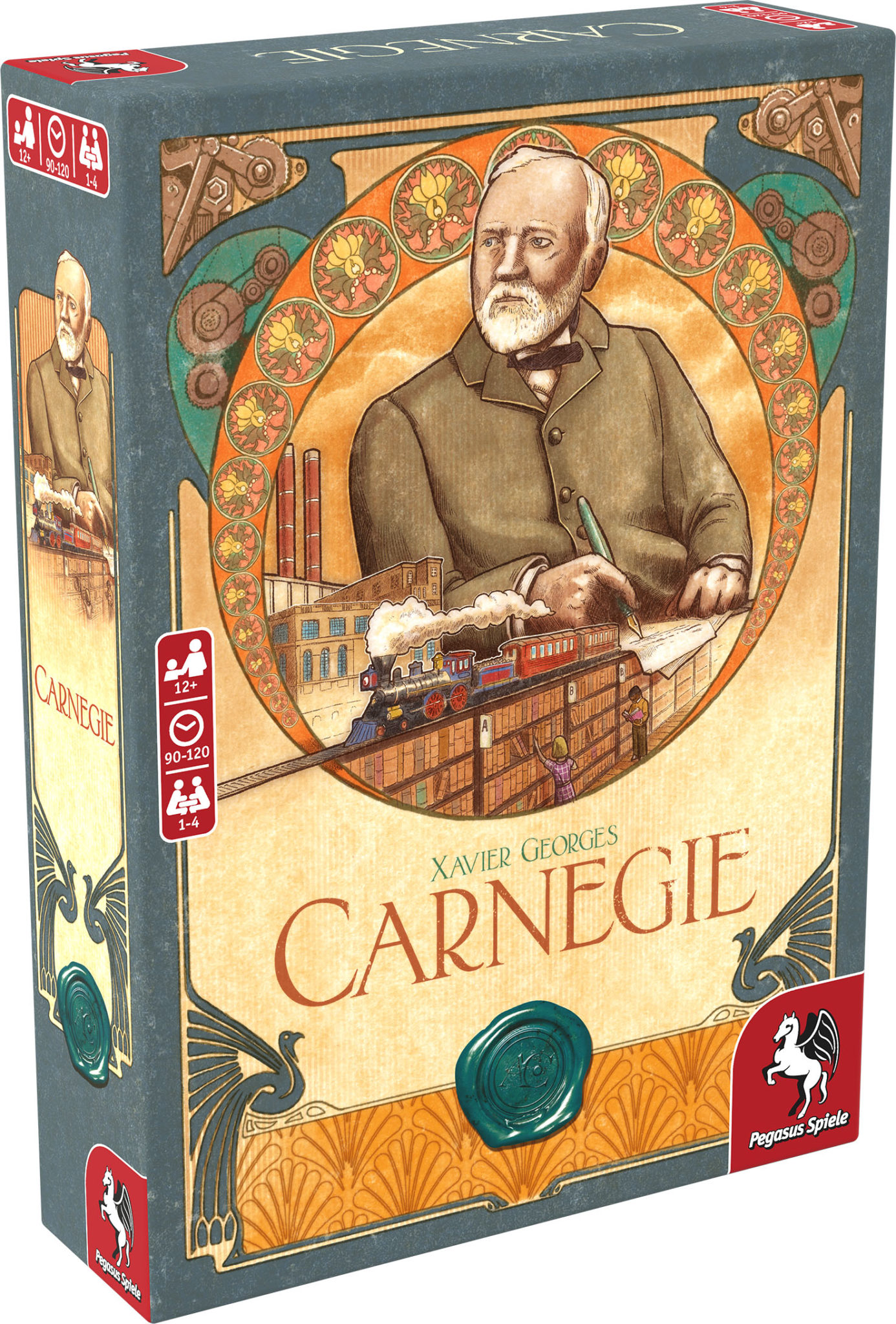
- 1 Game board of a map of the USA
- 4 Company boards
- 16 Project tabs (double sided, 4 for each player)
- 60 Employee meeples in 4 different colors (15 for each player)
- 120 Player discs in 4 different colors (30 for each player)
- 4 Action markers
- 8 Timeline tiles
- 4 Action choice tiles
- 1 Start and 1 End tile
- 4 Player aids
- 32 Department tiles (2 of 16 different departments)
- 45 Goods cubes
- 90 Banknotes in denominations of $1,$5, and $10
- 1 Timeline marker
- 1 First player marker
- 45 Solo cards
The components in the game are solid. I really like how you progress in the game and pull out tabs to gain more and more benefits. These tabs are designed well to not get caught and have problems when pulling them out, or placing them in at the beginning of the game. Everything else screams euro game as you are using disks, meeples, and cubes.
How’s It Play?
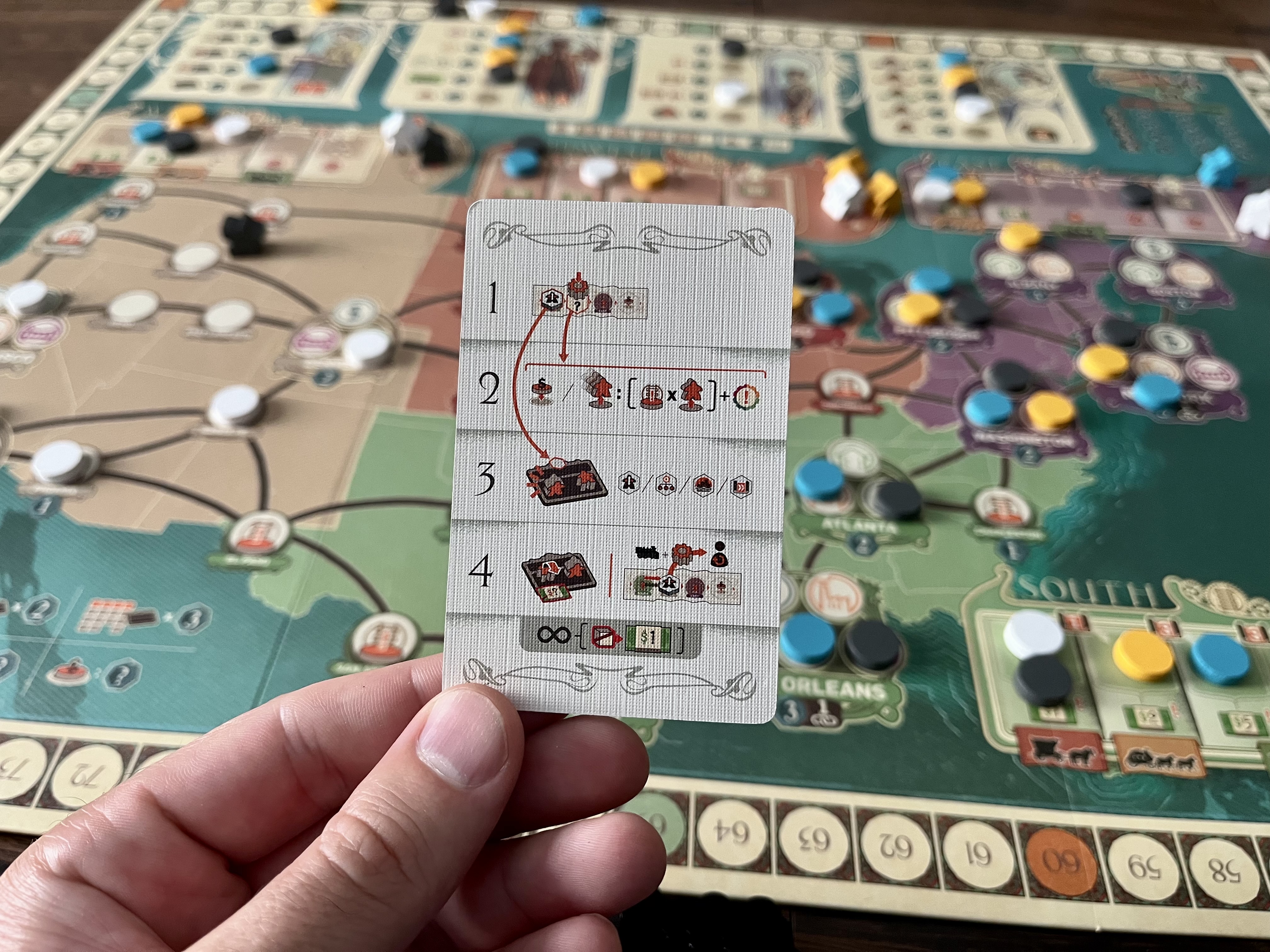
The game plays over 20 rounds with 4 parts that can take place on a turn. The starting player will selects an action to take on the timeline. When placing the timeline marker, events on the location will trigger. This will be an income step, a donation step, or possibly both when the marker gets to the end of its track. Players then activate departments that correspond with the action the player chose, and will activate their employees and then at the end of the turn will move the action marker once to the right.
This is really hard to imagine, but really once you understand the big picture, you can then figure out the small stuff and it all comes together very nicely.
Players all take the action that the first player chooses, and then the first player marker moves for the next round where the next player gets to choose the action for everyone to take. The timeline is important as it lists the possible actions to take, the events that occur, and keeps track of how many turns have occurred in the game.
The events allow players to take income, which gets better as the game progresses. Also, to make a donation, which is claiming how you will earn end game points. These are important to plan around. Before the player chooses which action they are taking you already know there are only 4 possible events they can trigger when they choose their action. Playing the game so you can take advantage of what event might occur can really help you out.
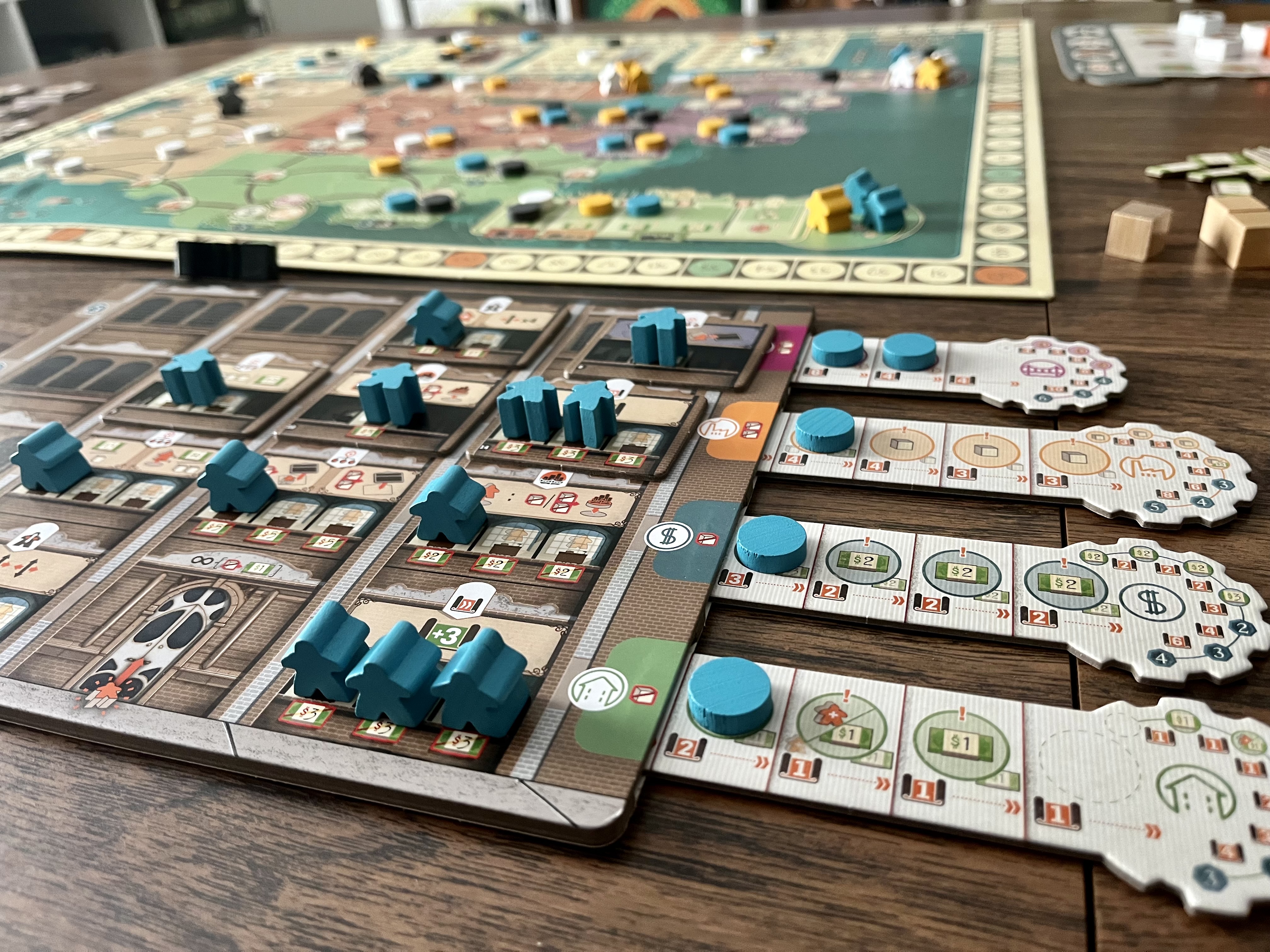
When taking income, you have to have one of your employees out on an active mission out on the board. There is an action to do this, so at the very beginning of the game, these actions will be skipped. Later when more employees are sent out, you can bring back as many in that region stated on the timeline to gain the bonus where your token is on in that region plus any income from your project tabs with uncovered spaces.
When making a donation, you will pay the amount depending on how many donations you have performed thus far. The first costs $5, second $10, and so on. Donations is a big part of what will determine a good amount of your end game points. There are 20 different options for donations, and you will have the chance to donate up to 6 times in the game if you have the money to do so.
The events can become important, but so are the actions you choose to perform. This is the action all other players will do as well, so if you are setup for a better action more than the others are, then you can better benefit from this choice. Again, there are 4 actions you can take, which all connect with the department tiles on your player board.
1. Human Resources – With this action you will calculate the total number of moves that you can make with your employees. Employees can move from department to department to make a different future action more powerful. All players will have a permanent meeple in this department to always receive 3 moves, but with more employees, the more movements you can make. You will move your meeples around and also possibly move meeples out for future departments.
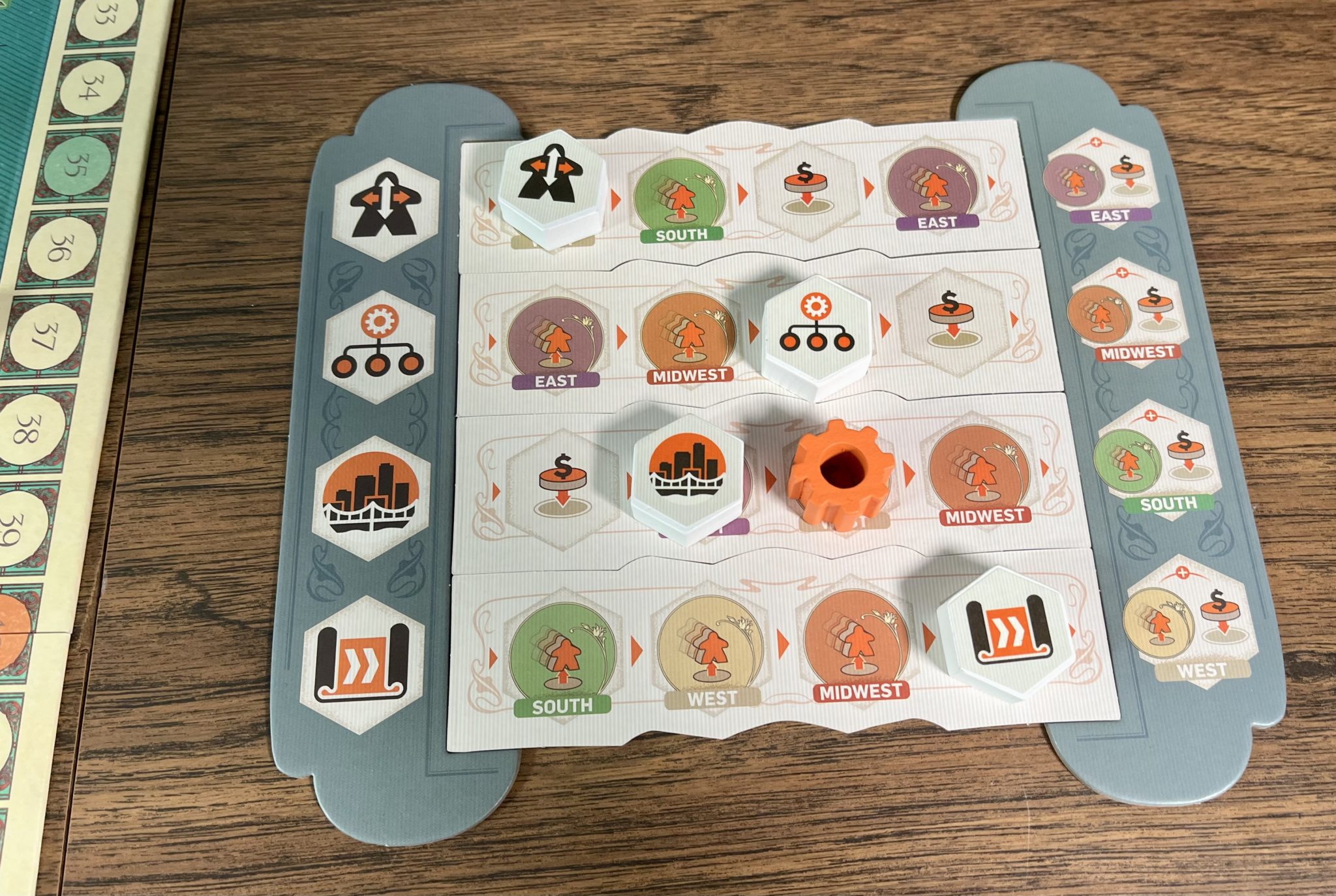
This actions is important as you will be cycling through employees from department to department while also managing them by sending them out on missions on the board, and bringing them back to again assign them to a new or same department. Some departments costs to train your employee for that department while others are free to train. Really, this action is all about managing your employees and putting them where they are most beneficial.
Overall – This action moves your employees around on your board
2. Management – Each player starts the game with two different management departments and can gain more as the game goes on. These departments will allow you to gain some money or a goods cube. If you send one of the current employees on this tile on a mission, you will gain twice as much money or number of goods cubes. And sending employees out on missions is a good way to collect income when that region is activated.
The other management department lets you pay goods to add new departments on your player board that provide additional actions of the 4 different types. It costs 1 goods cube if you have a employee on a free space, or you can pay 2 goods to place a new department on any other free space.
Overall – This action lets you gain money or goods, lets you send employees out on missions, and lets you add additional departments to your board.
3. Construction – With this action, you can send employees out on a mission to the same region where you will also pay 1 or 2 goods to place a disk out from one of your corresponding projects tabs. The type of project you choose needs to match the same type on the board in the same region as where you placed your employee out for a mission.
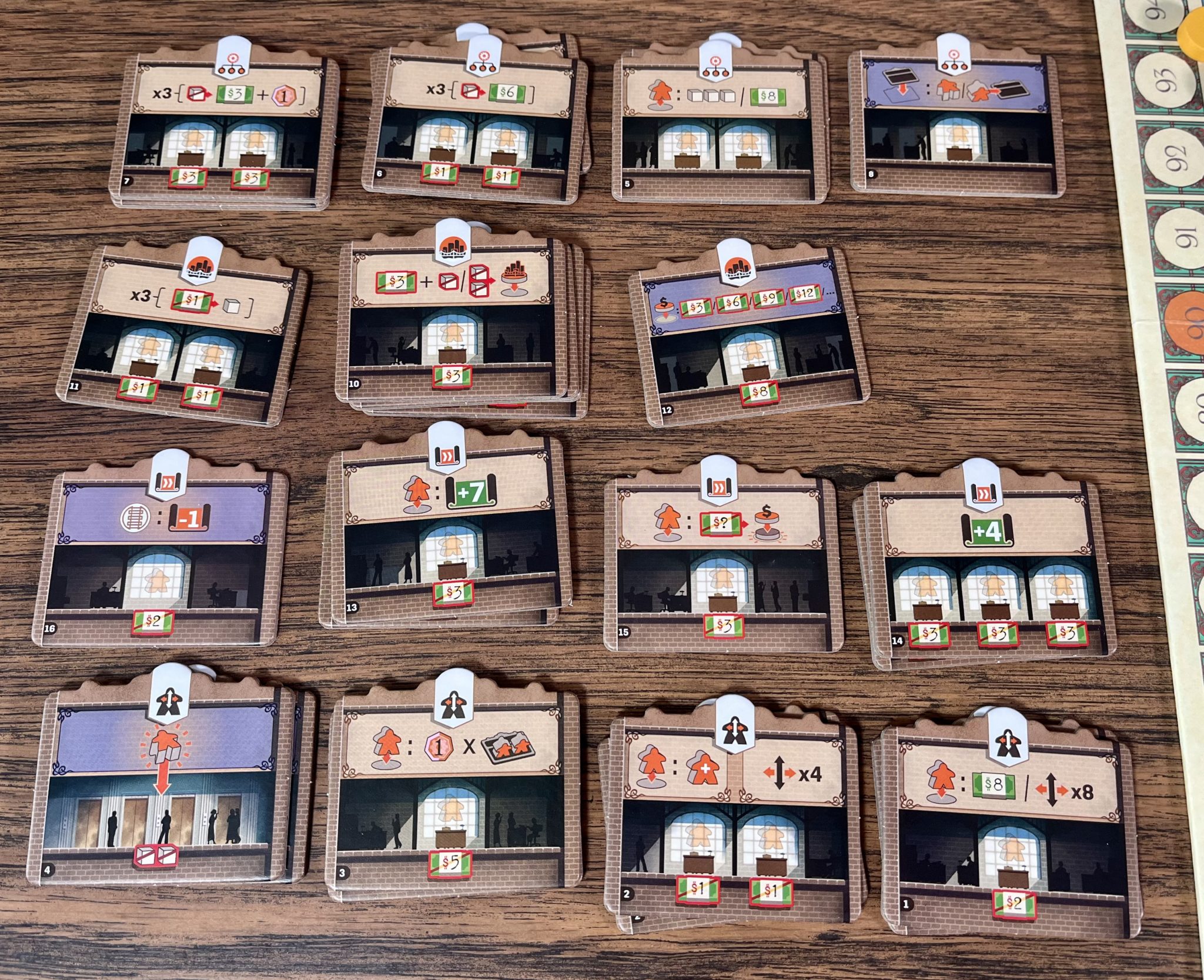
Adding disks out on the board will help to fulfill a lot of the end game scoring conditions shown in the donation section. You will also want to place disks so you connect major cities together. This is called “links”, where you can connect San Francisco, Chicago, New York, and New Orleans together to gain a certain amount of points. Chicago, New York, and New Orleans are closer together and easier to connect, so they are worth 1 link a piece, and San Francisco is worth 2 links because of how far it is from the others. You will then use a chart at the end of the game to see how many points you scored according to your links.
You will need to watch out as other players can block you from connecting your path to these cities. So pay attention to what others are doing, and if it important for you, you might need to pull the trigger to build in a certain city before another player does. There are also multiple paths to connect to each main city, so taking the long route might be safer, as less players will want to build in those cities. In addition there can be key cities that connect everything together. Playing aggressively to build there before others could benefit you if that is in your plans.
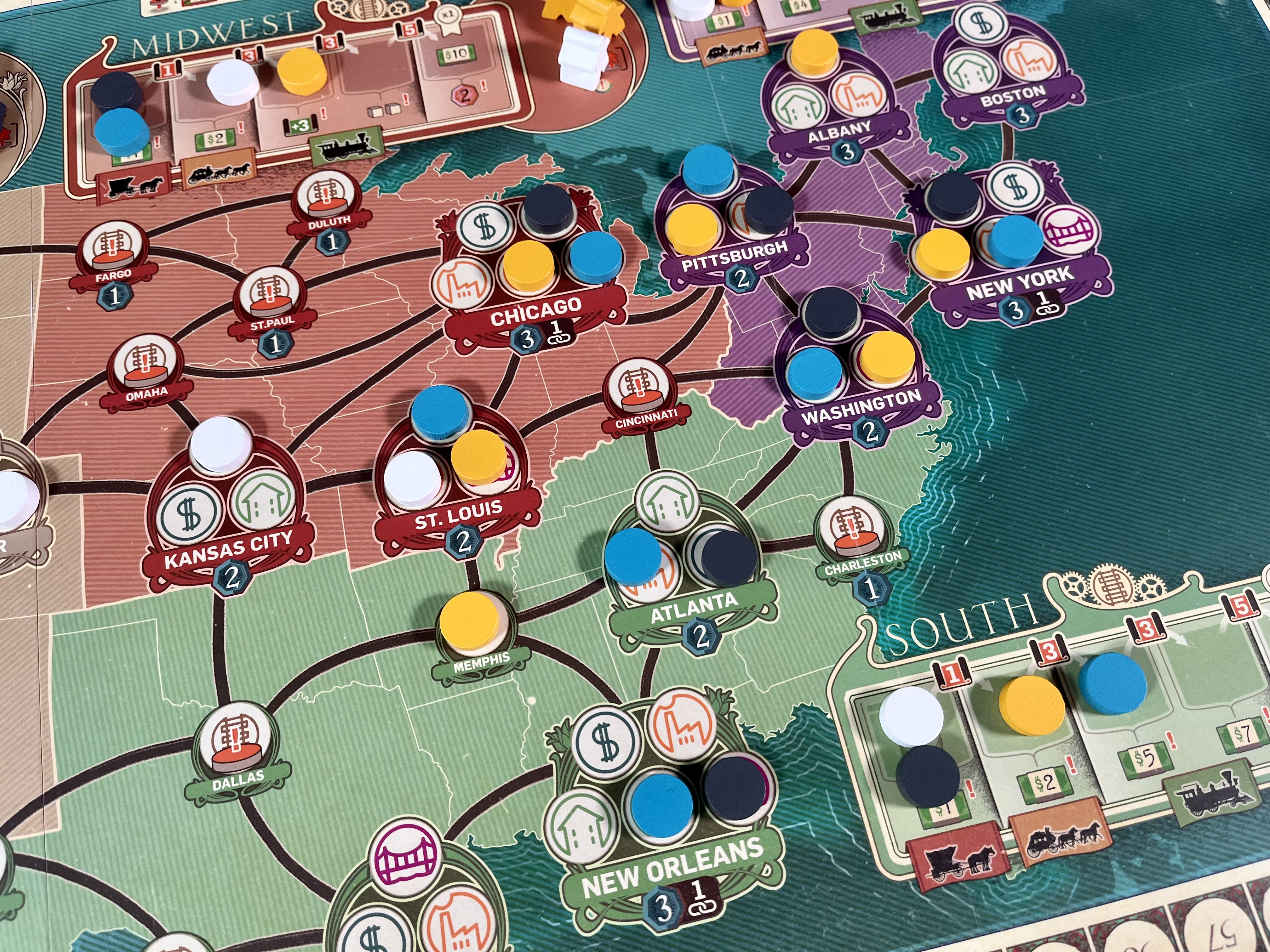
When placing disks on the board, you will uncover a bonus that you will gain when taking income. So them ore disks placed out, the more bonuses you gain when taking income.
Overall – This action will send employees out on missions, and let you lay out disks on the board.
4. Research & Development – With this action you will gain R&D points to use to move your transport disks on any region on the board, which will give you a better reward when taking income in that region. Or, you can also use your R&D points to pull out your project tabs, and placing a disk on it.
This action is important as it will give you more disks to be able to place out on the board when taking the construction action. Also, when some of the project tabs are pulled out far enough, you will start earning points that will be awarded at the end of the game.
Overall – This action will let you move your transport disks on each region on the board, and also let you pull out your project tabs further, adding more disks to be available to add to the map.
Players will all take 20 turns, and then the game will end.
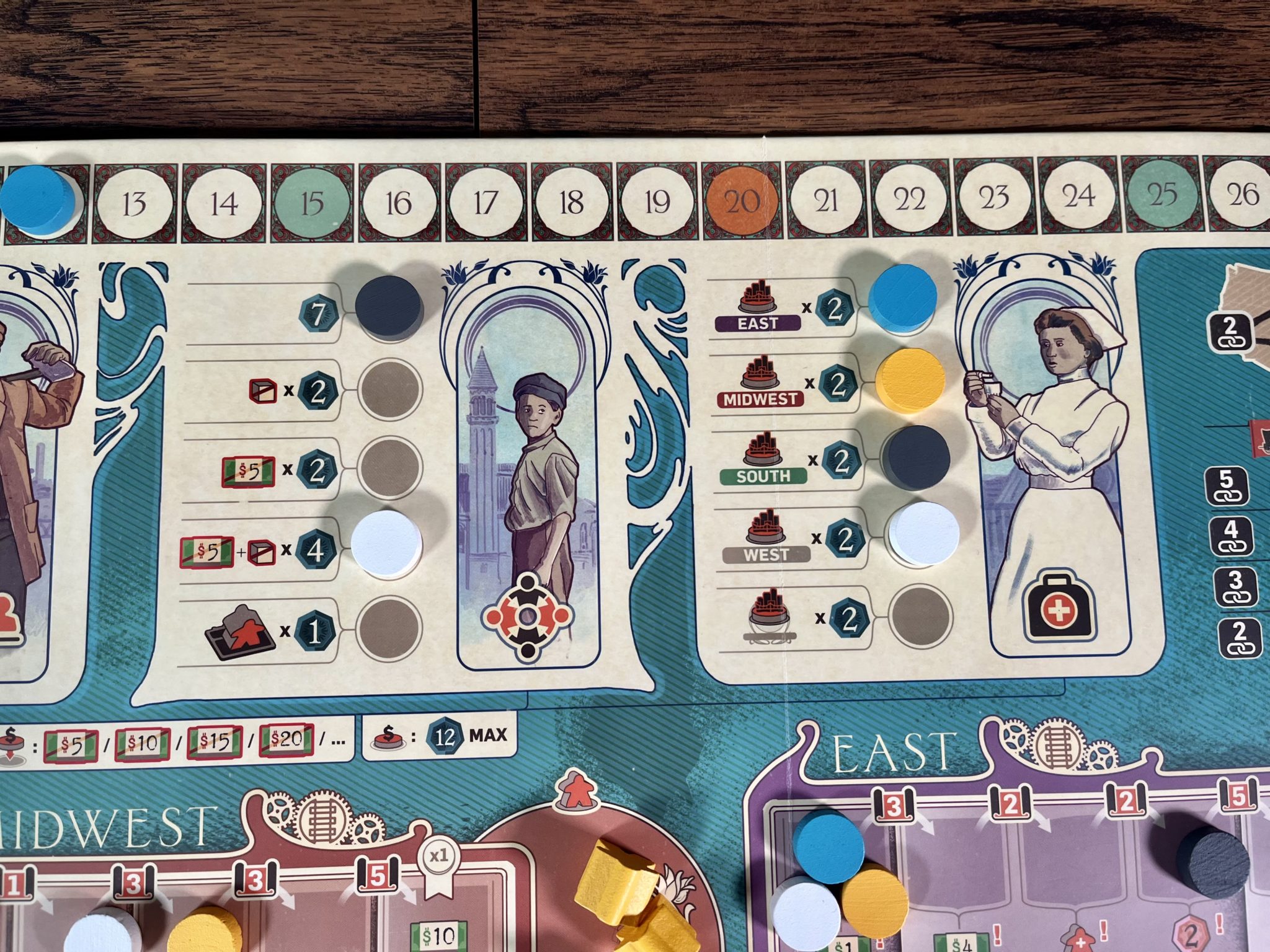
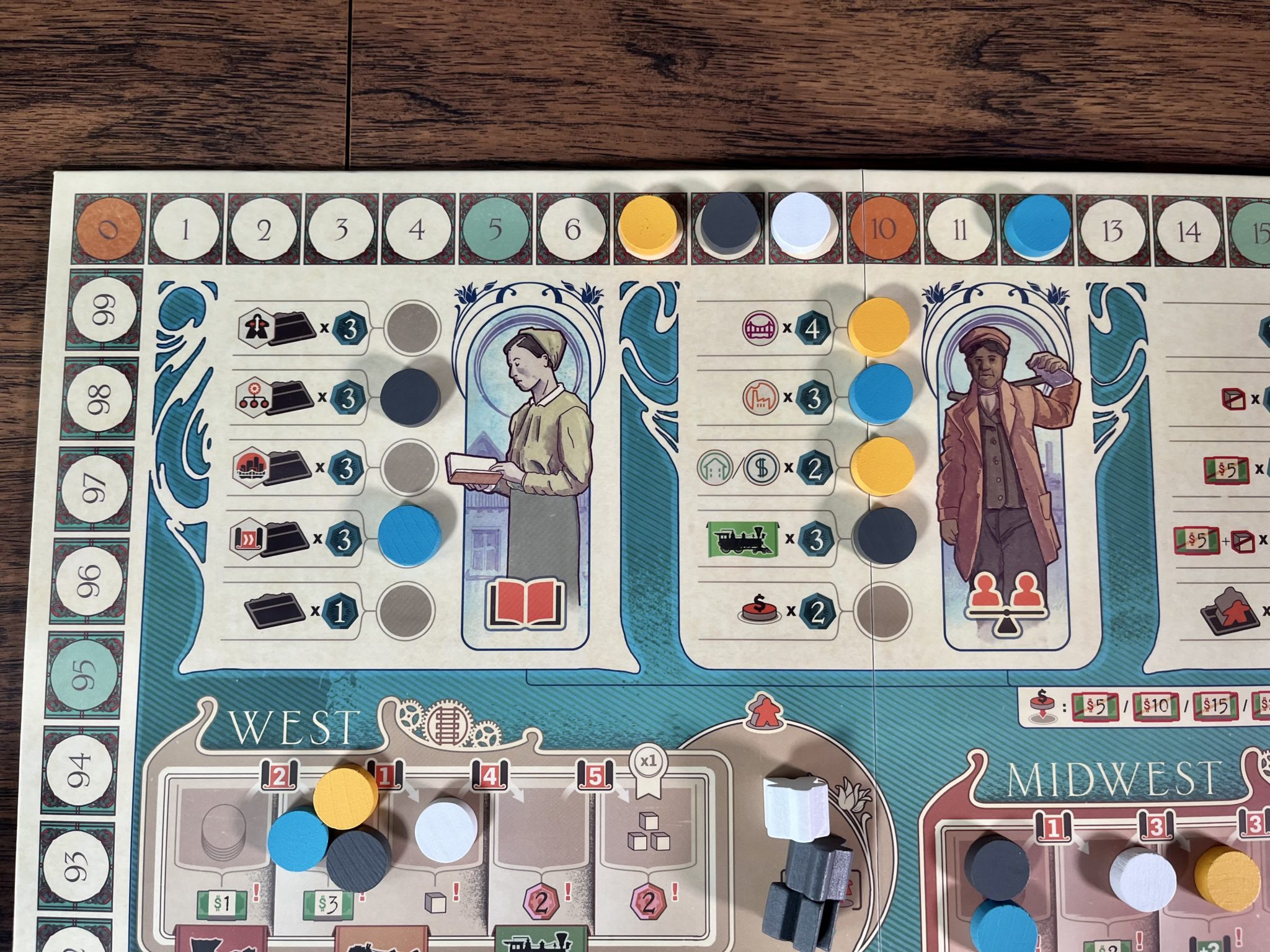
End game is done by calculating points in several ways. Each player might score some points during the game, but the end game points will be the bulk of all your points the game.
- Connections between major cities – you will score points for how many links you have made, compared to where your lowest level is on the transport track of those regions.
- 3 points will be awarded for unused action choice tiles.
- 1 point for each standing employee.
- 2-3 points for each department that was added during the game.
- Points for each project tab.
- Points for each disk built on a city with victory points associated with it.
- Points from each donation. (Maximum of 12 points per donation).
The player with the most points, wins the game.
Of course there are some smaller rules you will need to know to play the game, but this is a good overview of the main actions and what you will be doing in this game.
The Verdict
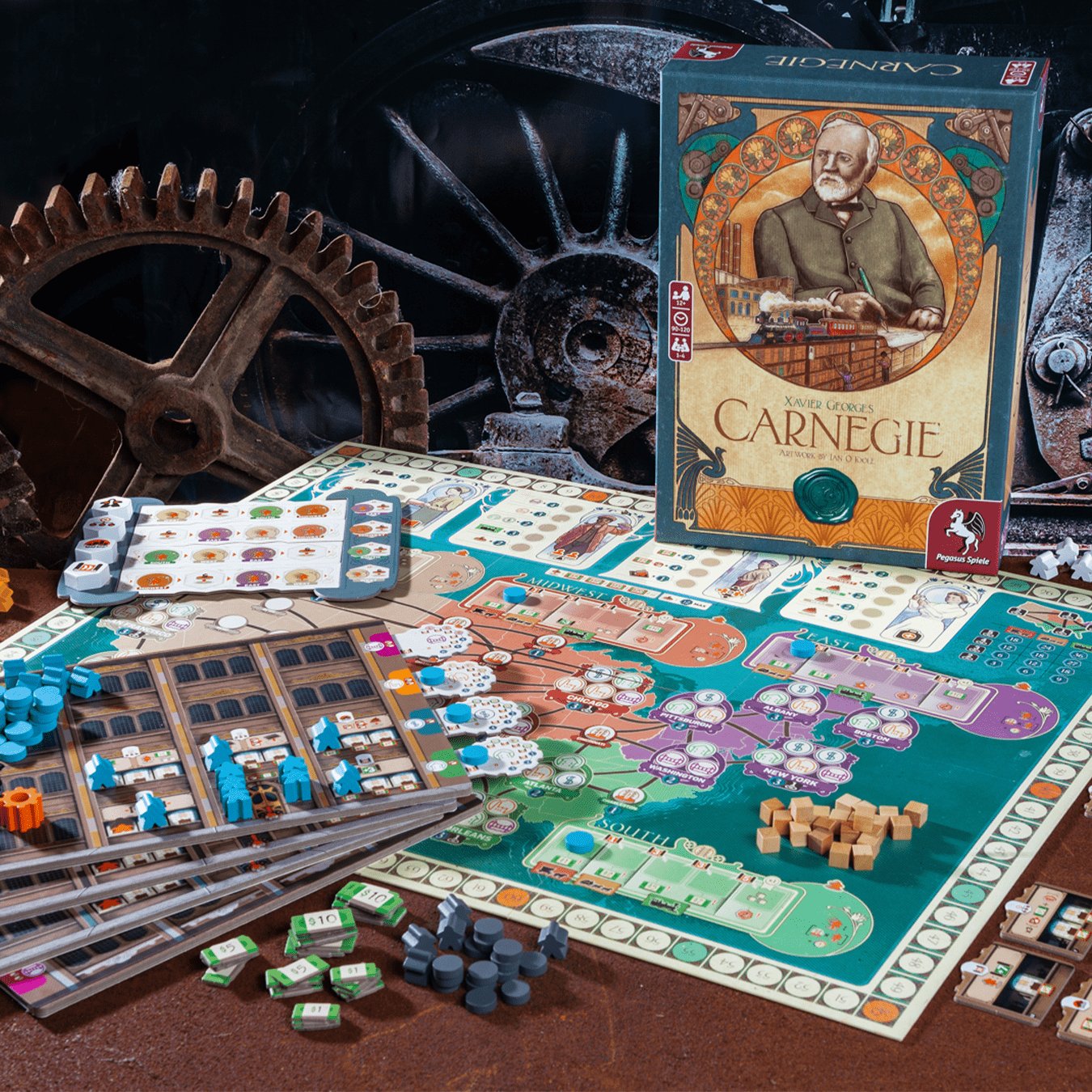
The game can seem complicated and hard to learn at first. I was intimidated when I first tried learning the game and trying to play the game myself, but as I learned the main rules, the rules that I have explained above, I figured out that really there are several main mechanics and focuses that need to be understood, and after figuring those things out, the other smaller aspects of the game fall into place pretty easily. So really, after seeing the big picture, the smaller stuff is easy to understand and add into the game.
One of the main reasons I think this game is so good and liked by many is because there are only four main actions which can be performed differently depending on each players added departments, but the ideas of those actions are very similar. Within those actions, there are four main regions on the board. If there were more actions or more regions, the game would feel way more complicated, but four of each is a great number. Those four actions also work so well together with the events that occur in the game. And the actions start small and slow, and grow until they become large and strong.
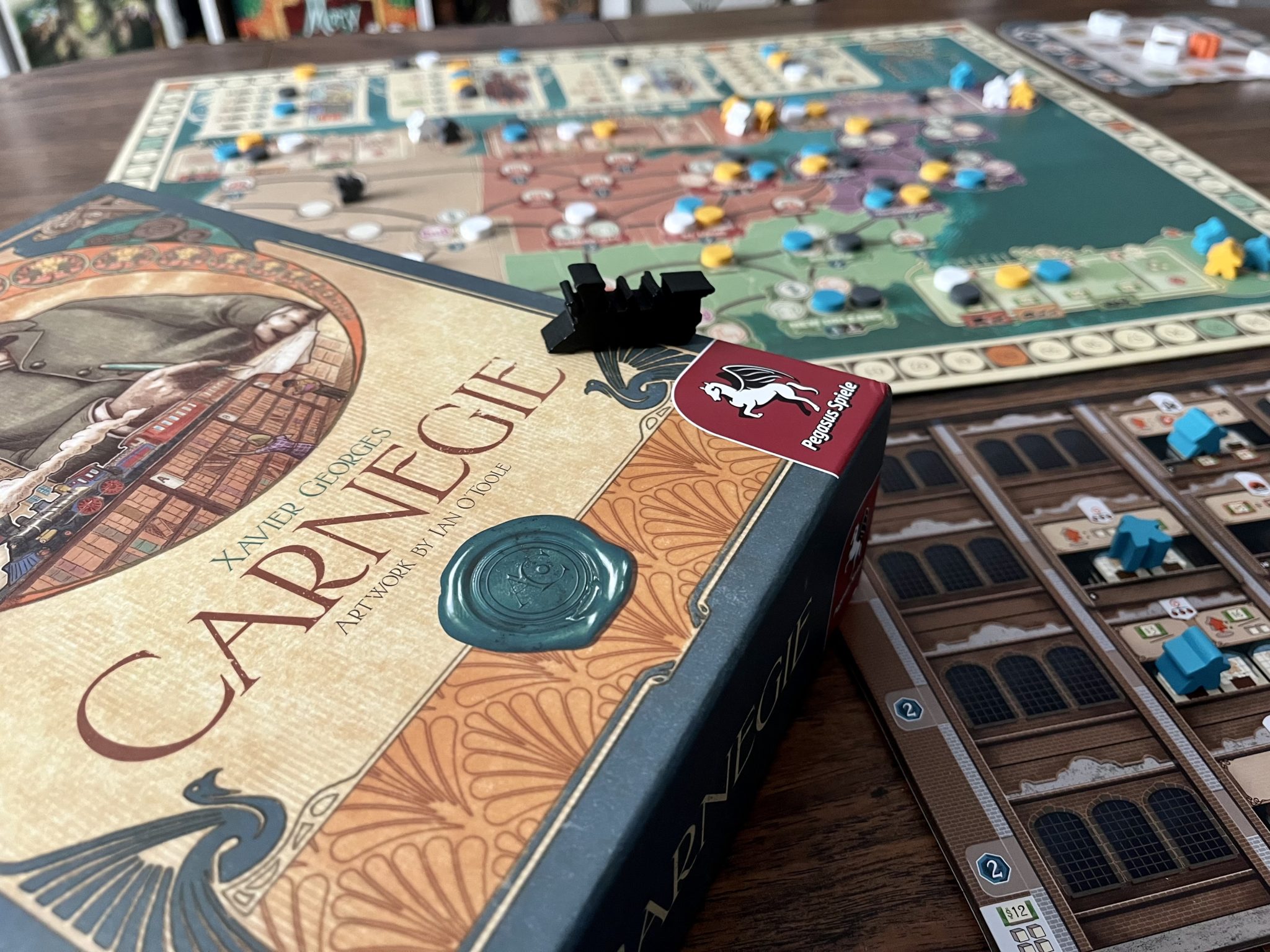
The game is well thought out, and the design is a pretty amazing. Of course, planning will be needed to do well in the game, but that planning never feels too heavy. As I mentioned above, the game gives a good satisfying feeling because you are expanding your company.
As you play the game you will always be trying to figure out how to play efficient enough that you spend your turn doing something beneficial for you more than another player. You want to get more new projects on your board, but you also want to make sure you have enough employees to do everything you want to do. Optimizing your board, and your employees by making sure you move them to the right spot and use the actions in the right order.
The income phase is unique and trying to figure out actions that other players are going to take next is fun to try to figure out. Of course income is important and gives the game an economy to give a flow to the game. If you do something wrong then it can really leave someone behind in the game.
Another idea in the game is to try to deprive other players of actions. If you can perform an action, maybe its not even the one you want to take, but when looking at all other players and they can’t even do anything when you do that action but you still can do something. This might be a good action to take because you will benefit more than others. If you choose the other action that you actually want to take, all other players are ready for that action and will benefit from it.
In addition to all these other aspects, you still want to make sure you are building out on the map and connecting the cities together. The player who just completely ignores this, will not do well. You don’t have to be the best at this aspect in the game, but you have to work at it and connect at least 3 cities together.
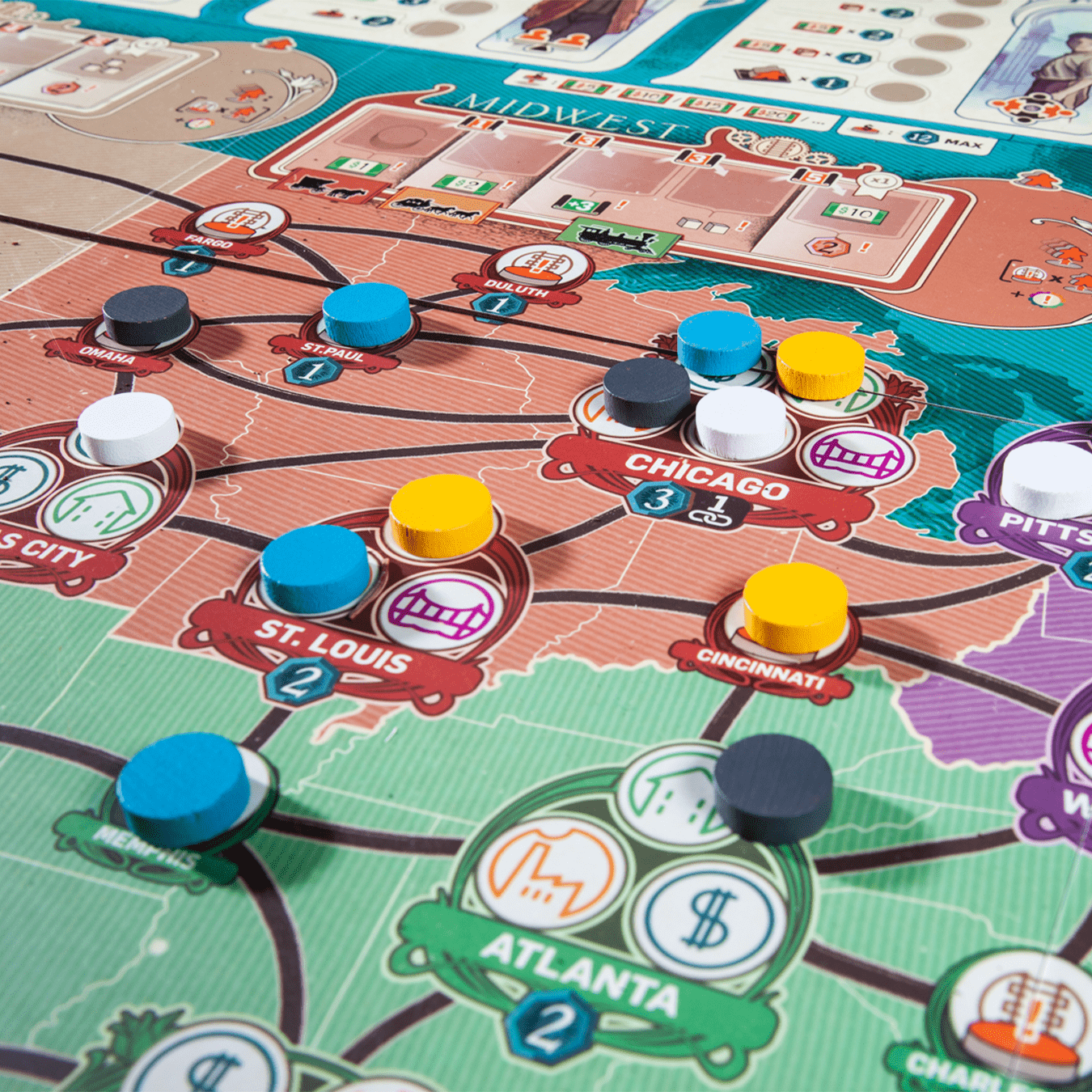
The goals are a great way to place a strategy down. The game changes each time when you have to place a disk on one of those, but sometimes choosing one near the beginning of the game can really help with direction. While choosing these later in the game will give you a lot more flexibility how you want to play, and then pin down your goals later when comparing to see which one will award you the most points.
Overall, this is one of the better euro games that I’ve played in a while. There are plenty of ways to gain resources, to score, and to develop a plan in the game to win. This game hits the right complexity for me. I feel like it is a medium heavy complexity game with a lot of variability.
You can pick up a copy of Carnegie from Pegasus Spiele (though it is sold out at the time of this writing, Sears (of all places), and of course your FLGS at an MSRP of $69.99.
Images via Pegasus Spiele
Have strong thoughts about this piece you need to share? Or maybe there’s something else on your mind you’re wanting to talk about with fellow Fandomentals? Head on over to our Community server to join in the conversation!

